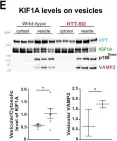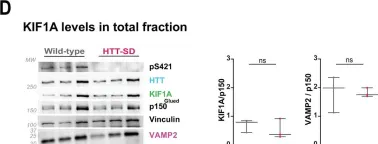Myosin phosphatase targeting subunit1 (MYPT1) is a critical subunit of myosin phosphatase (MP), which brings PP1Cδ phosphatase and its substrate together. We previously showed that MYPT1 depletion resulted in oblique chromatid segregation. Therefore, we hypothesized that MYPT1 may control microtubule-dependent motor activity. Dynein, a minus-end microtubule motor, is known to be involved in mitotic spindle assembly. We thus examined whether MYPT1 and dynein may interact. Proximity ligation assay and co-immunoprecipitation revealed that MYPT1 and dynein intermediate chain (DIC) were associated. We found that DIC phosphorylation is increased in MYPT1-depleted cells in vivo, and that MP was able to dephosphorylate DIC in vitro. MYPT1 depletion also altered the localization and motility of Rab7-containing vesicles. MYPT1-depletion dispersed the perinuclear Rab7 localization to the peripheral in interphase cells. The dispersed Rab7 localization was rescued by microinjection of a constitutively active, truncated MYPT1 mutant, supporting that MP is responsible for the altered Rab7 localization. Analyses of Rab7 vesicle trafficking also revealed that minus-end transport was reduced in MYPT1-depleted cells. These results suggest an unexpected role of MP: MP controls dynein activity in both mitotic and interphase cells, possibly by dephosphorylating dynein subunits including DIC.
© 2024 The Authors. Cytoskeleton published by Wiley Periodicals LLC.
Product Citations: 12
In Cytoskeleton (Hoboken, N.J.) on 1 December 2024 by Matsumura, F., Murayama, T., et al.
-
Cell Biology
Loss of ninein interferes with osteoclast formation and causes premature ossification.
In eLife on 5 June 2024 by Gilbert, T., Gorlt, C., et al.
Ninein is a centrosome protein that has been implicated in microtubule anchorage and centrosome cohesion. Mutations in the human NINEIN gene have been linked to Seckel syndrome and to a rare form of skeletal dysplasia. However, the role of ninein in skeletal development remains unknown. Here, we describe a ninein knockout mouse with advanced endochondral ossification during embryonic development. Although the long bones maintain a regular size, the absence of ninein delays the formation of the bone marrow cavity in the prenatal tibia. Likewise, intramembranous ossification in the skull is more developed, leading to a premature closure of the interfrontal suture. We demonstrate that ninein is strongly expressed in osteoclasts of control mice, and that its absence reduces the fusion of precursor cells into syncytial osteoclasts, whereas the number of osteoblasts remains unaffected. As a consequence, ninein-deficient osteoclasts have a reduced capacity to resorb bone. At the cellular level, the absence of ninein interferes with centrosomal microtubule organization, reduces centrosome cohesion, and provokes the loss of centrosome clustering in multinucleated mature osteoclasts. We propose that centrosomal ninein is important for osteoclast fusion, to enable a functional balance between bone-forming osteoblasts and bone-resorbing osteoclasts during skeletal development.
© 2024, Gilbert et al.
A farnesyl-dependent structural role for CENP-E in expansion of the fibrous corona.
In The Journal of Cell Biology on 1 January 2024 by Wu, J., Raas, M. W. D., et al.
Correct chromosome segregation during cell division depends on proper connections between spindle microtubules and kinetochores. During prometaphase, kinetochores are temporarily covered with a dense protein meshwork known as the fibrous corona. Formed by oligomerization of ROD/ZW10/ZWILCH-SPINDLY (RZZ-S) complexes, the fibrous corona promotes spindle assembly, chromosome orientation, and spindle checkpoint signaling. The molecular requirements for formation of the fibrous corona are not fully understood. Here, we show that the fibrous corona depends on the mitotic kinesin CENP-E and that poorly expanded fibrous coronas after CENP-E depletion are functionally compromised. This previously unrecognized role for CENP-E does not require its motor activity but instead is driven by farnesyl modification of its C-terminal kinetochore- and microtubule-binding domain. We show that in cells, CENP-E binds Spindly and recruits RZZ-S complexes to ectopic locations in a farnesyl-dependent manner. CENP-E is recruited to kinetochores following RZZ-S, and-while not required for RZZ-S oligomerization per se-promotes subsequent fibrous corona expansion. Our comparative genomics analyses suggest that the farnesylation motif in CENP-E orthologs emerged alongside the full RZZ-S module in an ancestral lineage close to the fungi-animal split (Obazoa), revealing potential conservation of the mechanisms for fibrous corona formation. Our results show that proper spindle assembly has a potentially conserved non-motor contribution from the kinesin CENP-E through stabilization of the fibrous corona meshwork during its formation.
© 2023 Wu et al.
-
Homo sapiens (Human)
-
Cell Biology
Loss of ninein interferes with osteoclast formation and causes premature ossification
Preprint on BioRxiv : the Preprint Server for Biology on 6 November 2023 by Gilbert, T., Barbier, M., et al.
Ninein is a centrosome protein that has been implicated in microtubule anchorage and centrosome cohesion. Mutations in the human ninein gene have been linked to Seckel syndrome and to a rare form of skeletal dysplasia. However, the role of ninein in skeletal development remains unknown. Here, we describe a ninein knockout mouse with advanced endochondral ossification during embryonic development. Although the long bones maintain a regular size, the absence of ninein delays the formation of the bone marrow cavity in the prenatal tibia. Likewise, intramembranous ossification in the skull is more developed, leading to a premature closure of the interfrontal suture. We demonstrate that ninein is strongly expressed in osteoclasts of control mice, and that its absence reduces the fusion of precursor cells into syncytial osteoclasts. As a consequence, ninein-deficient osteoclasts have a reduced capacity to resorb bone. At the cellular level, the absence of ninein interferes with centrosomal microtubule organization, reduces centrosome cohesion, and provokes the loss of centrosome clustering in multinucleated mature osteoclasts. We propose that centrosomal ninein is important for osteoclast fusion, to enable a functional balance between bone-forming osteoblasts and bone-resorbing osteoclasts during skeletal development.
In eLife on 11 July 2023 by Vitet, H., Bruyère, J., et al.
Neurotransmitters are released at synapses by synaptic vesicles (SVs), which originate from SV precursors (SVPs) that have traveled along the axon. Because each synapse maintains a pool of SVs, only a small fraction of which are released, it has been thought that axonal transport of SVPs does not affect synaptic function. Here, studying the corticostriatal network both in microfluidic devices and in mice, we find that phosphorylation of the Huntingtin protein (HTT) increases axonal transport of SVPs and synaptic glutamate release by recruiting the kinesin motor KIF1A. In mice, constitutive HTT phosphorylation causes SV over-accumulation at synapses, increases the probability of SV release, and impairs motor skill learning on the rotating rod. Silencing KIF1A in these mice restored SV transport and motor skill learning to wild-type levels. Axonal SVP transport within the corticostriatal network thus influences synaptic plasticity and motor skill learning.
© 2023, Vitet et al.
-
WB
-
Neuroscience
In Elife on 11 July 2023 by Vitet, H., Bruyère, J., et al.
Fig.5.E

-
WB
-
Collected and cropped from Elife by CiteAb, provided under a CC-BY license
Image 1 of 2
In Elife on 11 July 2023 by Vitet, H., Bruyère, J., et al.
Fig.5.D

-
WB
-
Collected and cropped from Elife by CiteAb, provided under a CC-BY license
Image 1 of 2

